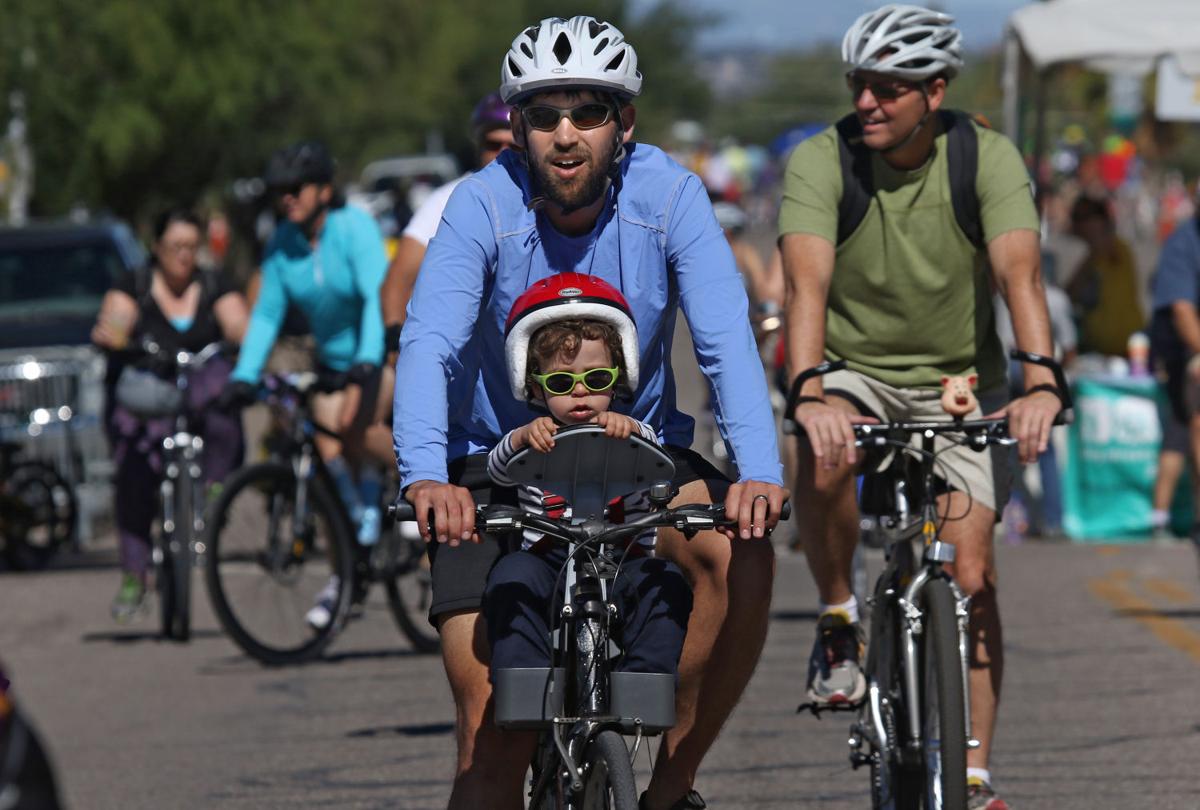The usual traffic in central Tucson will be turned on its head Sunday as about 30,000 pedestrians and bicyclists take over the streets.
The “car-free and carefree” Cyclovia event will run from 10 a.m. to 3 p.m. Sunday and wend its way along a 2.5-mile route from the Lost Barrio Shopping District on South Park Avenue to Himmel Park.
Without cars rumbling along the streets, “It’s actually really quiet,” said Kylie Walzak, Cyclovia Tucson coordinator for the Living Streets Alliance. “That’s the thing that always strikes me. It’s really calming.”
The event includes exhibits where people to stop and relax along the route. This year, a new exhibit is the Mindfulness Education Exchange, where people can take a “mindfulness minute” and sit down in the street, or near it, to breathe and observe, Walzak said.
Sunday marks the 10th Cyclovia Tucson event, which is held twice each year. The group doesn’t shy away from choosing ambitious routes, such as crossing Campbell Avenue. This time around, the path also crosses Broadway on Highland Avenue.
One of the first Cyclovia events was held in Bogota, Colombia, in the 1970s. The tradition continues today and most of the lanes on 75 miles of city roads are car-free during the weekly events.
Cyclovia then spread to cities across the globe, including U.S. cities such as Boulder, Colorado, and Tampa Bay, Florida.
In Tucson, the purpose of Cyclovia is to introduce bicyclists to the less-trafficked streets that run parallel to the busy streets in Tucson’s central neighborhoods, Walzak said.
The event is geared toward fun and games, but it raises an intriguing question: Aren’t roads designed for cars? The Cyclovia event certainly breaks the mold for how streets are used today, but if we could travel back in time to the late 1800s, the answer would be radically different.
Cars appeared decades after the first roads were built in the United States. Bicyclists, rather than motorists, were the first to lobby for improving the country’s road system, according to “Good Roads Everywhere,” a 2004 history published by the Arizona Department of Transportation.
The title of the report plays on the “good roads movement” that pushed for the creation of highways and state road systems in the 1890s. The movement “worked to improve rural roads to better support bicycle and wagon traffic and not motorized vehicles, which were only a curiosity before the turn of the century,” the ADOT report said.
In the late 1800s, paved bicycle paths stretched between cities in New York state, Carlton Reid wrote in his 2014 book “Roads Were Not Built for Cars.”
“Cyclists paid for these cycle paths themselves, paving the way, as it were, for the later taxes on motorists that helped pay for the interstate roads which, ironically, poured asphalt over the cycle paths, wiping them from the map, and memory,” Reid wrote.
The bicycle presented many Arizonans with their “first taste of independent mobility” and became wildly popular in Phoenix, Mark E. Pry wrote in 1990 in the Journal of Arizona History.
But “poor roads, primitive equipment, harsh conditions, resentful drivers, and the like” brought an end to pleasure cycling in Arizona, Pry wrote.
“The bicycle created and nourished a desire for speedy, flexible transportation — which it could satisfy only as long as it was the fastest vehicle around,” Pry wrote.
“When the automobile appeared on Arizona streets, the bicycle lost much of its luster as a technological wonder.”
Since World War II, most city planners in Arizona and elsewhere built cities to support car traffic, Walzak said. But that attitude is changing and more city planners are designing cities with bicycles in mind.
With regard to more practical matters, such as paying for permits, materials and training, the Cyclovia Tucson group is trying to raise $15,000. By the end of last week, the group was about halfway to its goal.
Donations can be made on the group’s website — www.cycloviatucson.org — or at booths on the day of the event.






